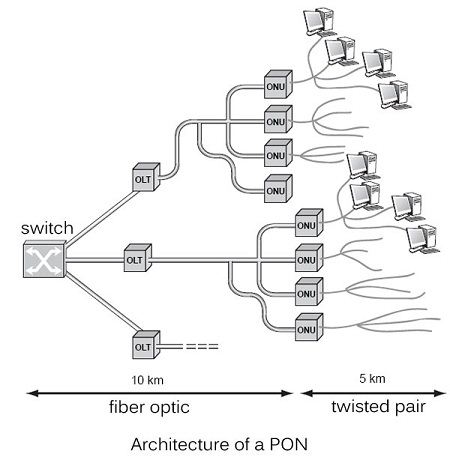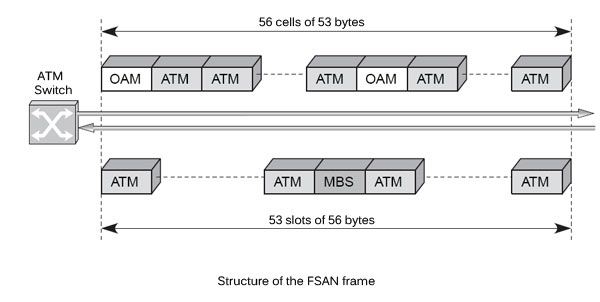On the Passive Optical Network (PON), it is possible to transit ATM cells according to the technique developed by the working group FSAN (Full Service Access Network). This solution was then standardized in G.983 recommendation ITU-T. Both ends of the optical shaft are called OLT (Optical Line Termination) and ONU (optical network unit). For reasons of energy loss, it is not possible to exceed fifty branches on the trunk. The figure illustrates the architecture of a passive optical network.
A “superPON” has also been defined, connecting up to 2,048 UN on a single OLT. In this case, the amount rate is 2.5 Gbit/s. On access fiber networks set up by the operators, the ATM protocol that was generally used at the beginning of this technology. The system then took the name of APON (ATM PON Over).
The difficulties caused by passive optical loops, such as access CATV, discussed below, come from sharing bandwidth uplink, that is to say from the user to the network. If several hundred clients connect simultaneously or thousands in superPON (up to 20,000) bandwidth may not be sufficient. If, on the downlink channel, the channels are broadcast video and take only channel on the tree, the channels amounts of users are all different and must share a certain bandwidth on the trunk. So you need a MAC access technique (Medium Access Control) to support this superposition. The wavelength-division multiplexing offers a simple solution to this problem, since each user has a different wavelength from that of other users. This can not, however, agree that if the number of branches is limited. We must solve most often to a sharing technique. Numerous solutions have been proposed to allow the UN to make a request to the OLT, the latter reserving bandwidth to requesting clients.

In the downlink direction, ATM cells are transmitted in a conventional manner, “Cellbased”. An OAM cell (Operations And Maintenance) is issued all 26 user cells to manage the flood. In the uplink direction, a reservation is required. It is carried out within the FSAN frames divided into slices of 56 bytes and including a cell 3 bytes supervision. In the center of the frame, a particular slice of 56 bytes is for reserving a time slot. Figure shows these data areas.

 Dinesh Thakur holds an B.C.A, MCDBA, MCSD certifications. Dinesh authors the hugely popular
Dinesh Thakur holds an B.C.A, MCDBA, MCSD certifications. Dinesh authors the hugely popular